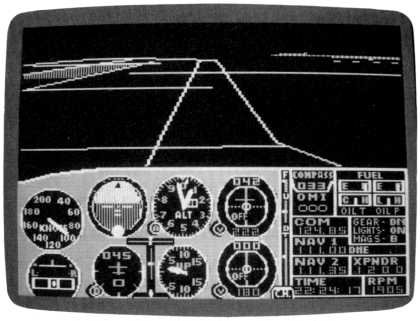40 More Great Flight Simulator Adventures
by Charles Gulick

Landing
Lights
The Manhattan Project VI
Lights
The Manhattan Project VI
| North Position: 17084 | Rudder: 32767 |
| East Position: 21178 | Ailerons: 32767 |
| Altitude: 82 | Flaps: 0 |
| Pitch: 0 | Elevators: 32767 |
| Bank: 0 | Time: 22:00 |
| Heading: 11 | Season: 2-Spring |
| Airspeed: 0 | Wind: 2 Kts, 20 |
| Throttle: 0 |
| Can we successfully identify
from the air, and successfully land at, your downtown Manhattan airport
at night? This mode gives you the chance to try. We're ready for takeoff on runway 1 at Republic Airport, Farmingdale, New York, a Long Island town about 30 miles from New York City. Let's not waste time. |
|
 |
Take off, climb out to 500 feet,
turn left heading 280 degrees, and get
straight and level at 2300 feet at your normal cruising airspeed. As you fly, watch for JFK off to your left, a major landmark in the area, particularly at night. The highway crossing your course, pointing to Kennedy, is Van Wyck Expressway (Interstate 678). Out the right front, meanwhile, La Guardia puts in an appearance. After the simulator accesses its disk, a bit more detail springs to life ahead. |
 |
Look carefully. Those two lines
jutting out from the general blaze of
city lights. Don't they look familiar? Remember the three key bridges
in our Manhattan Project, with their access highways? So where's the
third bridge? Where do you think? Take a closer look. Yep. Now you have a pretty good idea of where you are. That one vertical structure on the horizon must be ... what's the most imposing vertical structure in Manhattan? We took a heading of 280 from Republic. But that was arbitrary-nothing magic to it. Any reasonably westward heading would have given us a similar result. So if we'd just used our eyes in all directions, we'd have seen at least some if not all our checkpoints and had a good idea of our position. |
 |
Remembering that your airport is
north of the two downtown
bridges-Manhattan and Williamsburg-see if you can't make an educated
guess of its location. Maybe even see the little strip outlined on the
west side of the river if you look hard enough. Point your nose to try
to overfly your airport. As you come closer, you can clearly make out, just from the lights, the two bridges and where they cross the river. You know where the river is. Manhattan Bridge, in particular, takes on its familiar reality. Can you imagine how baffling all this would be if you hadn't overflown the whole area on your last several flights and memorized your landmarks? Don't rely on radar until you think you're over the general area of your airport. Then use radar and pause to check how accurate you were. Accurate or not, once you're beyond Manhattan Bridge, turn left to head about 220 degrees. Since the wind is from 20 degrees, we'll plan a landing to the north, with a little crosswind from the left. Reduce your power and get into pattern air speed and configuration at 1000 feet. |
 |
Look behind you as you descend
and see what you can identify. Looking
out front, see if you can tell what's water and what's land. Use radar,
too. We'll extend the downwind leg this time, since it's your airport and you can approve a straight-in approach from wherever you please. When you have pattern airspeed at 1000 feet, do a shallow 180 to the left, and when you're heading 40-45 degrees, consider how best to get lined up for your landing. If you're a ways out, you won't see much detail for a bit. The more or less straight line crossing your screen is the southern coast of Long Island. Use the Trade Center towers to estimate your distance. Remember, your airport is a bit north of them. And check for Kennedy to your right. Use radar frequently to see how you're doing, and correct your course as required, remembering you still want a heading of about 40 degrees on your final approach. Once you have a three-dimensional view of Manhattan Bridge in front of you, you're pretty well in the groove. The bridge, remember, is off to your right when you're on final to your lighted nighttime strip. You'll pass over the Williamsburg Bridge, too, before you land. Recall how everything looked out the rear view when you took off to the north. With a bit of practice, you'll soon find this is one of the most satisfying and realistic night landings in the simulator world. |
Table of Contents | Previous Section | Next Section
